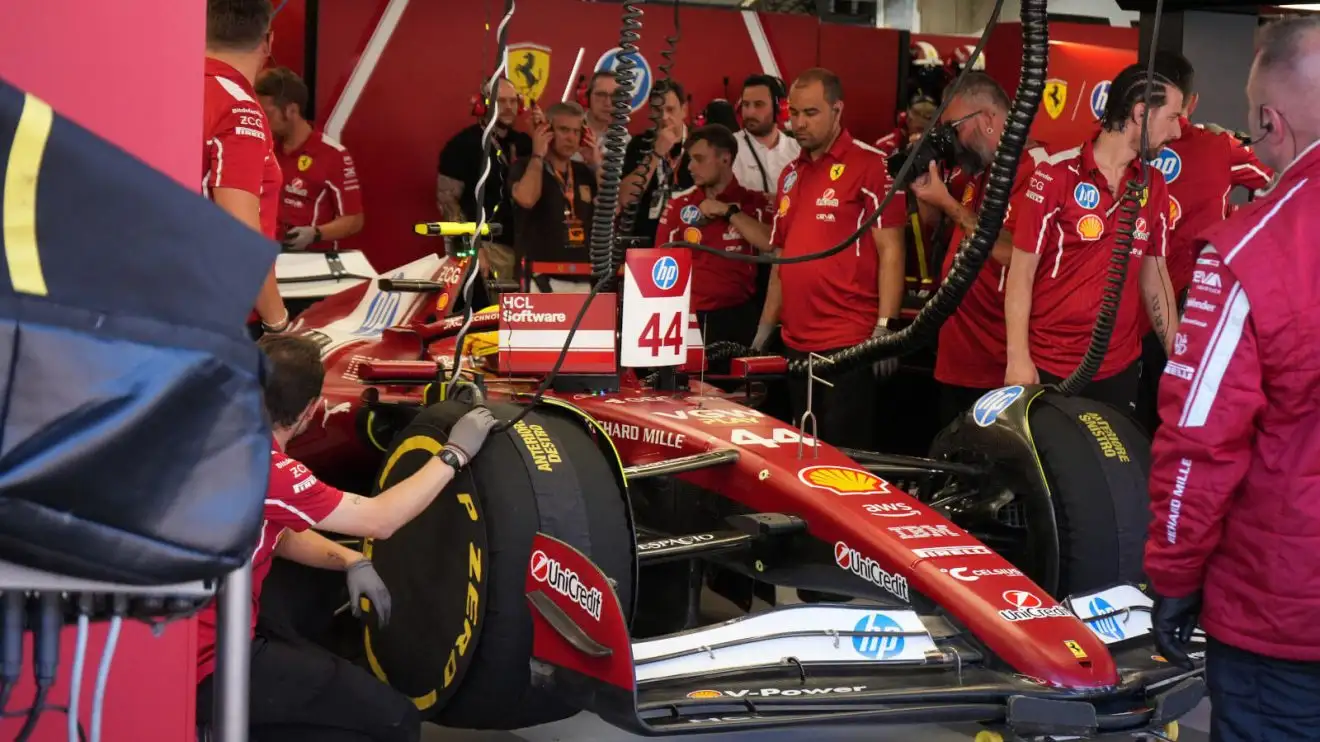In the high-octane theater of Formula 1, where billion-dollar machines are piloted by modern-day gladiators, the bond between a driver and his race engineer is sacred. It is a lifeline built on absolute trust, a symphony of shared data and raw human instinct. But on the final, agonizing lap of the 2025 United States Grand Prix, that lifeline snapped.
For Lewis Hamilton, the 55 laps preceding the chaos had been a display of surgical precision. In his new scarlet Ferrari SF-25, he had navigated the brutal, undulating tarmac of the Circuit of the Americas with intelligent pace.
Defending a solid fourth position, he was on track to secure valuable points, a soldier executing a flawless strategy. The race was in hand.
Then, in a handful of seconds, everything changed.
Diving into the famous high-speed esses, the sequence from Turn 3 to 10, Hamilton felt the car betray him. The steering, which moments before had been an extension of his will, suddenly went numb. A “brutal” and sudden wave of understeer washed over the car, refusing to respond. In a driver’s mind, this sensation means one of two things: catastrophic failure or a puncture.
Hamilton, a man with nearly two decades of instinct forged in the fire of competition, immediately assumed a right-front puncture. He did what any driver would: he lifted, braked early, and began wrestling the machine, his pace plummeting. In less than half a sector, he had bled almost four seconds. An eternity. In his mirrors, the papaya McLaren of Oscar Piastri grew larger, smelling blood.
Hamilton keyed his radio, reporting the critical failure. And from the Ferrari pit wall came the five words that turned a technical crisis into a human one: “Everything is fine.”
The sensors, the telemetry, the millions of data points streaming back to Maranello, all showed a healthy car. No pressure loss. No damage. No anomalies. As far as the computers were concerned, the car was perfect.
But inside the cockpit, Hamilton was a man betrayed. “I went into Turn 5 and felt like I hit something,” he recounted after the race. “I brake into Turn 11 and the car just didn’t want to stop. I thought, ‘What the hell is going on?’”
He was alone, fighting a ghost. The very team that serves as his eyes, ears, and external brain was telling him that his reality was wrong. This is the nightmare of every racing driver: to be at the absolute limit, to feel a critical failure in your hands and your gut, and to be told it isn’t happening.
And then, just as mysteriously as it arrived, the problem vanished.

Exiting Turn 11, the SF-25 suddenly woke up. The steering regained its precision. The massive understeer evaporated. It was as if someone had flipped a switch. With the coolness that has defined his career, Hamilton got back on the power. He fended off the charging Piastri, crossing the line to secure fourth place by a mere 1.1 seconds.
On the surface, it was a crisis averted. In reality, it was a warning shot. This incident, this “ghost in the machine,” was not a simple technical glitch. It was the symptom of a much deeper, more dangerous problem: a philosophical, strategic, and human fracture within Scuderia Ferrari.
What happened in Austin pulls back the curtain on a disconnect that has been simmering since Hamilton’s blockbuster move. For a driver accustomed to the excellence and “symbiotic relationship” he meticulously built at Mercedes, the slightest hint of technical disconnection is poison. When your engineer tells you everything is fine, but you can barely keep the car on the track, the problem is no longer in the steering rack. It’s in the trust.
The SF-25 is a car with character, but as the season has worn on, it’s proven to be an “unpredictable partner”—brilliant at times, dangerously fickle at others. This is the antithesis of the stable, logical, and reactive machines Hamilton spent over a decade developing at Mercedes. He didn’t just win championships there; he helped build an environment where driver intuition and hard data were woven into an unbreakable fabric.
At Ferrari, he has found an ecosystem still trapped by its “old ghosts.” This is not a new problem for the Prancing Horse. It is a chronic symptom that has plagued the team for over a decade: a stubborn, institutional prioritization of numbers over human perception. In Maranello, technology and data are king, often at the expense of the one variable they cannot simulate: the driver’s sensitivity.
An engineer sees telemetry. A driver feels the vibrations, the subtle shift in load, the change in grip, the whisper of the tires before they let go. Formula 1 is not a laboratory; it is, as the transcript narrator noted, “a war of sensations.” Ferrari, it seems, has replaced this symphony with noise. The communication is rigid, the response is cold, and there is little room for the emotional interpretation of a moment.
This “technical coldness” is paralyzing. When a driver hesitates, even for a fraction of a second, performance plummets. In Austin, Hamilton hesitated because he was forced to doubt his own team. This wasn’t the first crack. Weeks prior in Shanghai, the team was reportedly conservative with setup, and Hamilton’s post-race comments hinted at a disconnect. “There are still many things we want to change, but time is of the essence,” he said. It was a polite, coded warning: the team’s technical response is too slow.

The Austin incident was that warning amplified, a “silent scream” that resonated louder than any V6 engine. It was the brutal, tangible manifestation of an operational and emotional fracture that, if not repaired, can condemn an entire season.
Hamilton is not just any driver. He is a historical figure, a competitor who rewrites the rulebook by building winning environments from within. He took a Mercedes team struggling with new regulations and transformed it into a dynasty. He now faces a Ferrari that seems to be resisting that same transformation, a team that continues to trust the computer even when the seven-time world champion behind the wheel is telling them it’s wrong.
As the team investigates the “ghost”—perhaps a momentary loss of aerodynamic pressure, a blocked duct, or a thermal spike—the real damage is already done. A car can be fixed. A part can be replaced. But trust, once broken, is infinitely harder to rebuild.
When Lewis Hamilton was told “everything is fine” while he was fighting for control, what truly failed was not the front wing. It was the fundamental bond between driver and team. The seconds lost on the track were not just time; they were symbols of a team disastrously out of tune with its leader. Hamilton is now fighting an enemy he cannot see: an unpredictable car and a team that doesn’t seem to fully believe him.
